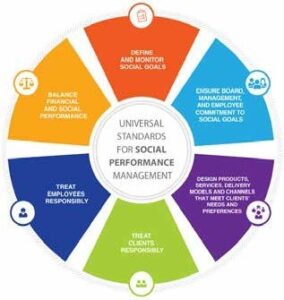This article was adapted from the Universal Standards for Social Performance Management Implementation Guide.
There are key initiatives that are currently driving positive change in Ghana’s microfinance sector. Together, these initiatives can improve the perceptions and patronage of microfinance in the country. In this article, two initiatives are discussed: Social Performance Management (SPM) and Client Service. These are practiced worldwide in various thriving microfinance sectors and are key drivers to achieving the purpose of microfinance, seeing improvements in the lives of clients, retaining clients, building sustainable businesses and in other cases facilitating access to capital. This article presents part one of the two areas. The remaining dimensions and subtopics will be addressed in subsequent editions of the GAMC Voice.
SOCIAL PERFORMANCE MANAGEMENT
Social Performance Management (or SPM, as it is known) is one of the two key dimensions for implementing responsible finance. SPM is essential for all double bottom-line institutions—those with both financial and social goals. Social performance management refers to:
- deliberate actions aimed at being sustainable and serving clients’ interests,
- including and reaching excluded people,
- protecting clients from harm,
- designing and delivering appropriate products that help clients cope with emergencies,
- investing in economic opportunities and building assets, as well as
- managing their daily and life-cycle financial needs.
Achieving these indicators however requires time and attention, and a balanced management approach. There are nineteen (19) standards categorized under six (6) dimensions. {http://sptf.info/ images/usspm%20 englishmanual%202014%201.pdf}
 |
The dimensions are as follows:
|
DIMENSION 1: DEFINING AND MONITORING SOCIAL GOALS
The first dimension seeks to have institutions articulate a social mission; define their target markets, social goals, social targets, social indicators; and articulate how products monitor client poverty levels, and publicly disclose social performance data including MIX social performance data.
The dimension usually calls for defining or redefining social goals of institutions, depending on whether or not the institution has social goals in place, or whether they are in-tune with the mission and vision of the institution. At times, there may be a need for board and management to sit and re- strategize or re-define their mission, vision, values and social goals as well as integrate SPM into their strategic plan.
Although it is not mandatory to start implementing SPM from this dimension, it is ideally the first point of call for institutions implementing SPM as it seeks to make them take a re-look at their social goals and structures. Many microfinance institutions across the world have implemented Social Performance Management and there is evidence to prove that the impact on the clients and on the institutions has been positive.
DIMENSION 2: ENSURE BOARD, MANAGEMENT AND EMPLOYEE COMMITMENT TO SOCIAL GOALS
The second dimension emphasizes on the importance of:
- having the board’s of microfinance institutions committed to their social mission;
- holding the microfinance institution accountable to its social mission and goals;
- ensuring that senior management sets, and oversees implementation of strategies for achieving social goals; and
- recruiting, evaluating and recognizing employees based on both social and financial performance criteria.
Under this dimension, the provider orients the board members on the social mission and goals, as well as the board’s social performance management responsibilities. The board would then use the social performance data to provide strategic direction, taking into account both the social and financial goals of the institution.
This dimension posits that the board holds the responsibility for the preservation of the MFIs social mission during times of institutional change and holds the CEO or managing director accountable for making progress toward realizing the MFI’s social goals.
Senior management oversees implementation of the MFI’s strategy for achieving its social goals, by operationalizing the social strategy, as well as analyzing and addressing social performance related risks. In effect, the CEO holds senior managers accountable for making progress toward achieving the social goals of the MFI’s.
Under this dimension, the recruitment and evaluation of employees is based on both the social and financial performance criteria. It ensures that job candidates are screened and hires for their commitment to the MFI’s social goals, matched by their ability to undertake the related responsibilities. It also ensures that the MFI trains and evaluates employees on both social and financial performance indicators that are related to their roles or positions. Additionally, it ensures that employee incentives promote progress toward the MFI’s social goals; and award incentives to staff who approve quality loans.
DIMENSION 3: DESIGN PRODUCTS, SERVICES AND DELIVERY CHANNELS THAT MEET CLIENTS’ NEEDS AND PREFERENCES
The third dimension seeks to:
- ensure that MFIs understand the needs and preferences of the different types of clients and that;
- its products, services and delivery channels are designed to benefit clients; and
- are in line with the MFI’s social goals.
To understand the needs and preferences of the different types of clients, an MFI ought to seek information on clients’ needs and preferences so as to inform product design and delivery. As an MFI, there is the need to regularly and effectively monitor the sustainability of products, services and delivery channels.
After doing so, MFIs would see to offering products and services that suit clients’ needs; and that are designed to reduce client risks and barriers to financial inclusion. The MFIs would also create benefits for clients by enabling them to invest in economic opportunities and address household needs. It will also put policies in place to prevent aggressive sales techniques, whilst at the same time monitoring risks.
Some questions for MFIs to ponder over are:
- As an MFI, are your products services and delivery channels designed and developed with the target client in mind?
- Do your products and services meet the needs of your client segment?
The universal standards of social performance management and client protection provide a detailed guide to achieving the double-ended objective of attaining both social and financial goals. You may read more on the universal standards and watch videos of institutions worldwide who have implemented social performance management in their institutions to learn how they did it and the results attained. You may also visit the Social Performance Taskforce (SPTF) website (www.sptf.info) where you can find information on SPM.
DIMENSION 4: TREAT CLIENTS RESPONSIBLY
The fourth dimension of the Universal standards seeks to ensure that the institution incorporates the client protection mechanisms in its operations be it its goals, interactions with clients, training of employees, and even the products and services offered. This dimension was developed taking into consideration and incorporating the Client Protection Principles (CPP). Under this dimension, the provider is encouraged to do the following:
Preventing over-indebtedness: Doing so by having a sound policy and well- documented processes; using credit reporting information; and maintaining a sound portfolio quality. Providing transparency on the institutions’ offerings and operations to clients: Doing so by being transparent and document product terms, conditions and pricing; and taking adequate steps to ensure that clients understand as well as supporting client decision making.
Treating clients fairly and respectfully: Doing so through promoting and enforcing the treatment of clients in line with a code of conduct; having a documented policy and processes to avoid discrimination; and ensuring that loans collection is done appropriately.
Privacy of Data: Doing so by ensuring that client data is kept secure and confidential; and that clients are informed about data privacy, and give consent to the use of their data by the institution.
Mechanisms for Complaints Resolution: The provider ensures that the institution has an effective system in place for receiving and resolving complaints; informs clients of their right to complain and how to submit the complaints; and uses the information received to manage and improve product and service quality.
DIMENSION 5: TREAT EMPLOYEES RESPONSIBLY
Dimension five (5) emphasises the importance of the provider creating a favourable working environment and ensuring that employees are protected, trained and motivated to achieve the institution’s social goals. One way or the other, employees play a major role in the success of institutions. High employee turnover is a huge cost that many employers do not want to incur. This dimension was developed incorporating the international labour law. Under this dimension providers are encouraged to do the following:
Have and follow a written Human Resource Policy that protects employees and creates a supportive working environment: Ensuring that the institution has a written HR policy that mirrors national labour laws; and that the policy is available to all employees, and explains their rights; the compensation levels of employees reflect competitive market rates; acceptance and responding to employee grievances through a formal and confidential system; and assesses employee health and safety, taking steps to mitigate them before they occur.
Communicate to all employees the terms of their employment and provide them with training that is essential to their job functions: Ensuring that employees receive clear documentation related to their job responsibilities and performance evaluation; and that employees receive job-specific training and/or skill development.
Monitor employee satisfaction and turnover: By analysing employee satisfaction; monitoring the rate of employee turnover and the reasons behind their exit; and taking action to correct problems that lead to employee dissatisfaction and turnover.
DIMENSION 6: BALANCE FINANCIAL AND SOCIAL PERFORMANCE
Businesses strive to attain financial sustainability and make profits. The Universal Standards of Social Performance Management shows that we can achieve this, and still achieve social performance obligations. The sixth dimension emphasises the importance of the provider balancing the institution’s financial and social performance (i.e. pursuing financial sustainability and social performance). Under this dimension, providers are encouraged to:
- Set and monitor growth rates that promote both institutional sustainability and social goals;
- Ensure that equity investors, lenders, board and management are aligned on the provider’s social goals and implement appropriate financial structures in its mix of sources, terms and desired returns;
- Ensure that prices are set responsibly; and
- Ensure that senior managers are compensated in a way that is appropriate to providers with stated social goals.
HOW WERE THE UNIVERSAL STANDARDS CREATED?
The Universal Standards were not randomly created. They were created when the Social Performance Task Force (SPTF) invited four hundred (400) people from stakeholder groups to provide input. The stakeholders included representatives from the SMART Campaign, the Imp-Act Consortium, MFTransparency, Microsave, Cerise, The Progress out of Poverty Index, and the International Labour Organization. It also sought the contributions of consultants, practitioners and other key industry players from around the world.
SO WHERE DOES A PROVIDER START WITH SPM AND ITS STANDARDS?
There is no set order for implementation. There are many possible starting points to improve on the practise of the institution. However, there are five (5) steps that provide a practical approach for financial service providers, which can be adopted. These steps are:
Include infographic/smart art
CONCLUSION
There are video cases online of financial service providers who have learnt about SPM, implemented it, and documented the processes they used in achieving their goals. Some examples such as Ugafode Microfinance in Uganda, Mission Africa in Ethiopia, Contactar and many others can be found on the Social Performance Taskforce (SPTF) website at www.sptf.info, along with the SPI4 assessment tool and other resource documents.
Remember, as you implement SPM in your institution, the most important thing to do is to document the process! As you learn from others, give others the opportunity to also learn from you. The good news is that as you document and share, donors and funders who have interest in SPM will be drawn to your institution.
By Angela Esi Daisie

